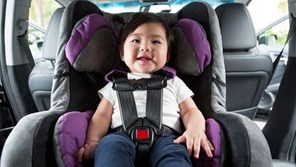Child safety in the car
7 minute read

To keep your grandchildren safe when travelling with them, it’s important that your car contains the correct safety equipment, including car seats and booster seats. Below, you can find the laws around what height and age children should be to use these safety items and when they’re no longer needed.

Over 50s Car Insurance
Age Co helps drivers stay protected on the road. We’re 100% owned by Age UK and our profits go back to the charity.
Car seats
Child car seats are designed to protect children's vulnerable bodies at each stage of development. Babies and toddlers need different levels of protection to older children, so when you’re buying a car seat you need to make sure you're getting one that is suitable specifically for babies and toddlers.
Does a child need a car seat?
Children must have a car seat until they’re at least 12 years old or 135cm (4ft 5in) tall. There is some flexibility on this when it comes to booster seats, but generally, children who are over 12 or taller than 135cm can simply wear a seatbelt with no additional safety measures.
Car seats are most commonly grouped by weight and each group defines what type of seat your child should have based on how much they weigh.
|
Group 0 (0 to 10kg/1 stone 8lb) |
Group 0+ (0 to 13kg/2 stone 1lb) |
Group 1 (9 to 18kg/1 stone 5lb to 2 stone 11lb) |
Group 2 (15 to 25kg/2 stone 5 lb to 3 stone 13lb) Group 3 (22 to 36kg/3 stone 6lb to 5 stone 9lb) |
|
Should be in a lie-flat or ‘lateral’ baby carrier, rear-facing baby carrier, or rear-facing baby seat using a harness |
Should be in a rear-facing baby carrier or rear-facing baby seat using a harness |
Should be in a rear- or forward-facing baby seat that has a harness or safety shield |
Should be in a rear- or forward-facing child car seat (high-backed booster seat or booster cushion) and using a seat belt, harness or safety shield |
To put this in perspective, a child will reach 9kg (1 stone 5lb) when they are approximately nine months old. This means, as your grandchild is growing, it’s important to check they’re in the right kind of seat for their weight, as they may occasionally need an upgrade to a different kind of seat.

As well as weight-based seat sizing, there is also a height-based system. These are known as i-Size seats. i-Size is part of R129, a new regulation for child car seats that was introduced in 2013.
The idea behind i-Size is that all car seats with the i-Size logo will fit in all i-Size approved cars. Your car and your car seat must have Isofix, a fitting system that attaches car seats directly to the frame of your car using connectors. i-Size/R129 seats are based on a child's height (instead of weight). The new seats don't replace the weight-based seats, they just give you an alternative.
i-Size seats come in three main sizes:
- 0-85cm
- 0-105cm
- 100-135cm
When can a child face forwards in a car seat?
It’s safer for young children and babies to face backwards when travelling in a car. This is because if you’re in a collision, the impact is likely to throw things in the car forwards. Children will be able to face forwards in the car once their muscles and bones have developed a bit more.
For i-Size seats, babies stay rear facing until they are at least 15 months old. You can keep your child facing backwards for longer than this if you want to ‒ this is just the minimum age. If you are using a weight-based car seat, the child can face forwards when they reach a minimum of 13kg (approximately 12 to 15 months old).
Can a child wear a coat in a car seat?
It’s generally advised that children and babies shouldn’t wear very bulky coats or clothes while they’re strapped into their car seats. This is because the harness won’t fasten as tightly as it should and could result in it being too loose to be effective should an incident occur.
For this reason, it’s best to strap your grandchildren in while they’re wearing lighter clothing. During winter, you can keep them warm by placing a blanket over them or by encouraging them to put their coat on backwards after they’re strapped in ‒ their arms can go through the jacket so it acts as a blanket.
How long can a baby stay in a car seat?
The general rule is that babies (children up to a year old) can stay in a car seat a maximum of two hours. This is because being in a partially upright position can put pressure on their spine and even restrict airflow to their lungs. The two-hour rule is recommended by the manufacturers of child car seats and is for a 24-hour period. This means that you can’t drive for two hours, take the baby out for a bit and put them back in almost straight away, for example. So when planning a holiday with the grandchildren, aim to keep them in the car for less than two hours per day to adhere to this safety rule.
Booster seats
A booster can be placed in the back of the car for the child to sit on. The booster works by raising the child to the correct height so that the seatbelt, which slots onto either side of the seat, fits around them safely and comfortably. Some booster seats are available as high-back varieties too, and it’s thought that these are generally the safest option, thanks to the additional back and neck support. They may also be the more comfortable choice for longer drives and road trips.
UK law states that children must use a child car seat until they're 12 years old or 135cm (4ft 5in) tall, whichever comes first. It's legal to use booster seats or booster cushions as car seats for children who are either old or tall enough to no longer need a car seat.

When can a child use a booster seat?
Some booster cushions are approved for use with children weighing 15kg (2 stone 5lb) or more, but any new backless booster seats on the market (manufactured after 1 March 2017) can only be used with children weighing more than 22kg (3 stone 6lb), and taller than 125cm.This means they must use a car seat until both of these restrictions are reached (it must be both, and not just one).
In some instances, older booster seats made before March 2017 can be used for children that weigh between 15 and 36kg (approximately 2 stone 5lb to 5 stone 9lb). The best thing to do is check the manual or usage guidelines created by the manufacturer to see what they recommend.
If in doubt about whether your grandchild can or can’t use this type of car seat, it’s best to choose a high-back variety or a car seat until they’re over 12 years old or taller than 135cm.
What age can a child sit in the front seat?
Children can sit in the front seat when they no longer need a car or booster seat. This means that they should be at least 12 years old or taller than 135cm (4ft 5in).
However, a child can sit in the front with a car seat if there are already two children in car seats in the back. This would be an ideal solution if you have three grandchildren and wish to take them all out for the day.
When this is the case, you should deactivate any airbags on the passenger side and also slide their seat back as far as it will go.
We’ve provided a lot of information in this guide about child safety, but if you’re still unsure, the manufacturers will provide ample information when you buy a car seat, so you can be safe in the knowledge that it’s the right size for your grandchildren and will protect them during a car journey.
For more information on driving in later life, try exploring the rest of Age Co's Useful Articles.

Sign up to the Age Co Newsletter
Each month, our email newsletter delivers inspiring stories, practical guides to later life, plus the latest news about Age Co and the charitable work we support.
